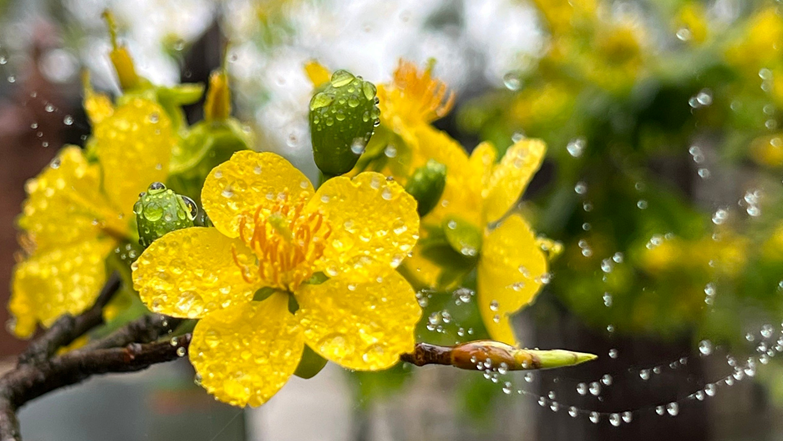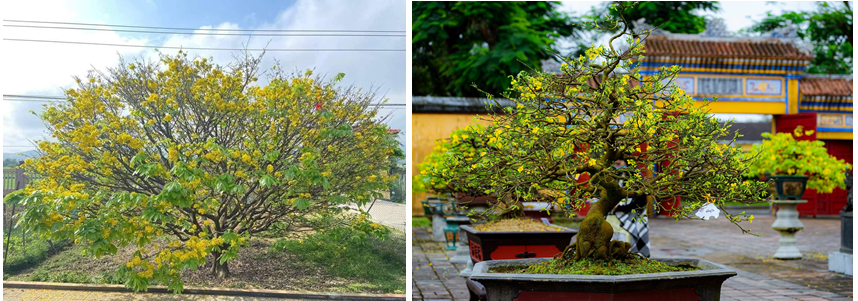 Xuất bản thông tin
Xuất bản thông tin
Th 3, 27/05/2025 | 16:56 CH
Geographical indication protection "Hue" for yellow apricot products (Ochna integerrima)
On January 18, 2024, the Intellectual Property Office issued Decision No. 10/QD-SHTT on granting Geographical Indication Registration Certificate No. 00134 for "Hue" yellow apricot products (Ochna integerrima). The Department of Science and Technology of Thua Thien Hue province is the organization that manages this geographical indication.
Hue Ochna integerrima has a history spanning hundreds of years and is documented in numerous historical records. In the "Dai Nam Nhat Thong Chi," under the section "Types of Flowers (Local Products)" in the Imperial City (Hue), it states: "Hoang Mai flower, commonly known as Ochna integerrima blossom, is recorded in herbal texts as Lap mai". The legend of this flower dates back to the time of Lord Nguyen Hoang (Thai To) in the harsh land of O Chau in 1558, while the appreciation of Ochna integerrima blossoms in Hue may have emerged over 700 years ago, coinciding with the founding of Thuan Hoa[1] . The book "Grand ceremonial costume under Nguyen dynasty (1802-1945)" records the five-petal yellow apricot blossom as a common decorative motif on royal ceremonial robes. Additionally, Hue Ochna integerrima is also depicted in architectural works across the city, linked to historical and spiritual landmarks. With its noble elegance, the Hoang Mai holds a significant role in Hue's cultural life.
Hue Ochna integerrima is characterized by its green buds, dense branches (dam chi), short-stemmed flowers, 05 deep yellow petals with wavy edges, flat surfaces, tightly overlapping petals, and a distinctive mild fragrance.


Hue Ochna integerrima has gained its unique characteristics and reputation thanks to the natural geographical conditions and the expertise of local residents in its cultivation.
Located in the northern hemisphere's tropical belt and blessed with abundant solar radiation, Thua Thien Hue Province enjoys high temperatures, creating ideal conditions for the growth and development of Ochna integerrima. While June, July, and August (the months when Ochna integerrima flower buds form) are rainy seasons in the northern region (Yen Tu) and the southern region (Vinh Long), Thua Thien Hue experiences a dry and hot period. The ample sunlight and high temperatures facilitate vigorous carbohydrate metabolism, making it easier for the trees to differentiate flower buds. When the first rain of the wet season arrives, the growth of flower buds and the formation of flower buds proceed smoothly.
In the geographical region, the Ochna integerrimas are cultivated in light-textured soil dominated by sandy particles, which facilitates good drainage, aligning with the biological characteristics of the Ochna integerrima - a species sensitive to waterlogging and requiring loose, porous soil. The soil for growing Ochna integerrimas is rich in humus, as local farmers use alluvial soil from river basins within the province and mix or fertilize it with high organic content. The high humus content improves soil drainage and water retention while supplying essential nutrients for the tree's growth, particularly the development of new shoots, making them denser (thick branches). Compared to the yellow apricot-growing soil in Vinh Long province, the Hue Ochna integerrima cultivation area has higher available potassium levels, ensuring the maintenance of Hue Ochna integerrima flowers' distinctive color and fragrance. Additionally, when compared to Binh Dinh and Vinh Long provinces, the iron content in the Ochna integerrima - growing soil of Thua Thien Hue is lower. Sulfur plays a role in enhancing floral fragrance, so Hue Ochna integerrimas grown in Hue soil exhibit a characteristic mild and delicate aroma.
The unique characteristics and quality of Hue's Ochna integerrima blossoms, aside from being influenced by natural geographical conditions, are also shaped by stable technical factors. To preserve the distinctiveness of Hue Ochna integerrima, growers in the selected geographical area choose purebred Ochna integerrima seedlings from robust mother trees, propagated by seeds within Thua Thien Hue province.
Growers of Hue Ochna integerrima blossoms are very meticulous in preparing the soil for planting. Accordingly, whether planted in gardens or pots, Hue Ochna integerrima blossoms must maintain a distance from other Ochna integerrima varieties to avoid natural cross-pollination, which could affect the distinctive characteristics of the Hue Ochna integerrima blossoms.
For potted Ochna integerrima trees, the distinctive feature in Thua Thien Hue is the completely different mixing ratio, with a notably high proportion of sand (30% sand). This is due to the harsh natural conditions of the geographical area, where rainfall is approximately 3 times that of Vinh Long and about 2 times that of Yen Tu, requiring growers to mix in more sand to ensure proper drainage.
Hue Ochna integerrima blossoms typically grow at a slower pace compared to those from other regions (Binh Dinh, Vinh Long) (a 5-year-old Hue Ochna integerrima tree is often only equivalent to a 2-year-old five-petal Ochna integerrima tree from other regions). As a result, pruning practices among Hue Ochna integerrima growers are limited to trimming excess branches that disrupt the tree's intended shape, unlike the more aggressive pruning of one-third to half the branches practiced by growers in Vinh Long and Binh Dinh. This pruning method serves dual purposes: preserving the distinctive form of Hue Ochna integerrimas while also ensuring their floral characteristics and abundant branching.
Unlike other regions where the use of inorganic NPK fertilizers is quite common, in Thua Thien Hue province, Ochna integerrima growers limit the use of inorganic fertilizers to preserve both the trees and the soil. Growers and traders of Hue Ochna integerrimas often use organic fertilizers to nourish the trees, especially during the stages when flower buds begin to form and develop (from June to September of the lunar calendar). In this geographic area, there are three key stages for fertilizing Ochna integerrimas: the first around early February in the lunar calendar with high-nitrogen organic fertilizer; the second around June - July of the lunar calendar with high-phosphorus organic fertilizer; and the third around September-October of the lunar calendar with high-potassium organic fertilizer.
The regulation of flowering according to the wishes of the people of Hue is carried out solely through manual techniques without the use of flowering stimulants. Specifically, all leaves are stripped/plucked within 01-03 days, approximately 30 to 45 days before the Lunar New Year, depending on weather observations (sunny, rainy, warm, cold) and the condition of the Ochna integerrima (if the buds are not yet plump, the leaves are plucked a few days earlier; if the flower buds are firm and about to burst through their husks, the plucking is delayed by a few days). This ensures that the Ochna integerrima blossoms bloom uniformly during the Tet holiday and maintains the unique characteristics of the product. The timing of leaf stripping/plucking by Hue growers also differs from other regions such as Vinh Long and Binh Dinh, typically occurring 20 days earlier.
The combination of natural elements and time-honored production methods has created the reputation and distinctiveness of Hue Ochna integerrima.
The geographical area includes Hue City, Huong Tra Town, Huong Thuy Town, A Luoi District, Nam Dong District, Phong Dien District, Phu Loc District, Phu Vang District, and Quang Dien District of Thua Thien Hue province.
Source: Bảo hộ chỉ dẫn địa lý “Huế” cho sản phẩm Hoàng mai (mai vàng)
Translator: Nguyễn Hải Phong
[1] Nguyễn Anh Huy, Admiring the Ochna integerrima blossoms, 2016, Xưa và Nay Magazine.
Tin mới nhất
- Geographical indication protection "Lam Dong" for coffee products
- Geographical indication protection "Lai Chau" for tea products
- Geographical indication protection "Dong Thap" for lotus product
- Geographical indication protection "Luc Ngan" for orange products
- Geographical indication protection "Ben Luc Long An" for seedless lime products
Các tin khác
- Geographical indication protection "Hue" for Thanh tra grapefruit products
- Geographical indication protection "Binh Dinh" for yellow apricot products
- Geographical indication protection "Thanh Phu" for rice products
- Geographical indication protection "Nam O" for fish sauce products
- Geographical indication protection "Ben Tre" for clam products

